Performance Assessment and Comparative Analysis of Photovoltaic-Battery System Scheduling in an Existing Zero-Energy House Based on Reinforcement Learning Control
Abstract
:1. Introduction
1.1. Literature Review
1.1.1. Building Energy System Management
1.1.2. Challenges of Building Energy System Control
1.1.3. Reinforcement Learning
1.2. Research Contributions
- We formulate the operation problem of a hybrid energy system in ZEHs as Markov decision processes (MDP). Additionally, we adopt model-based RL algorithms to optimize the operation problem and design an appropriate reward function to guide the energy system operation. The proposed reward function considers the physical constraints of the battery and the energy cost.
- Measured data of a ZEH are applied to train and test the RL agents. The proposed approaches achieve outstanding operation performances utilizing a relatively small amount of data.
- The scheduling performances of Q-learning, DQN, and DDPG agents are compared. The study demonstrates the cost-effectiveness of the proposed RL control approach in different seasons.
2. Methodology
2.1. Reinforcement Learning
2.2. Q-Learning
2.3. Deep Q Network
2.4. Deep Deterministic Policy Gradient
3. Experiment Design
3.1. Reinforcement Learning Agent Design
3.1.1. System State
3.1.2. Control Action
3.1.3. Reward Function
3.1.4. Parameter Settings
3.2. Rule-Based Operation
3.3. Data Resource and Evaluation Method
4. Results and Discussions
4.1. Training Performance
4.2. Analysis of Testing Results
4.2.1. Effect of ZEH Energy System Scheduling
4.2.2. PV Self-Consumption
4.2.3. Energy Cost Saving
5. Conclusions
Author Contributions
Funding
Data Availability Statement
Conflicts of Interest
Nomenclature
| DDQN | Double deep Q network |
| DQN | Deep Q network |
| DR | Demand response |
| DSM | Demand-side management |
| HVAC | Heating, ventilation and air conditioning |
| MDP | Markov decision processes |
| MPC | Model predictive control |
| PV | Photovoltaic |
| RL | Reinforcement learning |
| SOC | State of charge |
| TD3 | Twin-delayed deep deterministic policy gradient |
| ZEH | Zero-energy house |
References
- Li, H.; Wang, Z.; Hong, T.; Piette, M.A. Energy flexibility of residential buildings: A systematic review of characterization and quantification methods and applications. Adv. Appl. Energy 2021, 3, 100054. [Google Scholar] [CrossRef]
- Hu, S.; Yan, D. China Building Energy Use and Carbon Emission Yearbook 2021: A Roadmap to Carbon Neutrality by 2060; Springer Nature: Singapore, 2022. [Google Scholar]
- Niu, J.; Zhou, R.; Tian, Z.; Zhu, J.; Lu, Y.; Ma, J. Energy-saving potential analysis for a 24-h operating chiller plant using the model-based global optimization method. J. Build. Eng. 2023, 69, 106213. [Google Scholar] [CrossRef]
- Li, Y.; Wang, Z.; Xu, W.; Gao, W.; Xu, Y.; Xiao, F. Modeling and energy dynamic control for a ZEH via hybrid model-based deep reinforcement learning. Energy 2023, 277, 127627. [Google Scholar] [CrossRef]
- Zhang, W.; Yan, C.; Xu, Y.; Fang, J.; Pan, Y. A critical review of the performance evaluation and optimization of grid interactions between zero-energy buildings and power grids. Sustain. Cities Soc. 2022, 86, 104123. [Google Scholar] [CrossRef]
- Wu, Y.; Wu, Y.; Guerrero, J.M.; Vasquez, J.C. Decentralized transactive energy community in edge grid with positive buildings and interactive electric vehicles. Int. J. Electr. Power Energy Syst. 2022, 135, 107510. [Google Scholar] [CrossRef]
- Wu, Y.; Liu, Z.; Li, B.; Liu, J.; Zhang, L. Energy management strategy and optimal battery capacity for flexible PV-battery system under time-of-use tariff. Renew. Energy 2022, 200, 558–570. [Google Scholar] [CrossRef]
- He, F.; Bo, R.; Hu, C.; Meng, X.; Gao, W. Employing spiral fins to improve the thermal performance of phase-change materials in shell-tube latent heat storage units. Renew. Energy 2023, 203, 518–528. [Google Scholar] [CrossRef]
- Jin, X.; Xiao, F.; Zhang, C.; Chen, Z. Semi-supervised learning based framework for urban level building electricity consumption prediction. Appl. Energy 2022, 328, 120210. [Google Scholar] [CrossRef]
- Tang, H.; Wang, S.; Li, H. Flexibility categorization, sources, capabilities and technologies for energy-flexible and grid-responsive buildings: State-of-the-art and future perspective. Energy 2020, 219, 119598. [Google Scholar] [CrossRef]
- Eslami, M.; Nahani, P. How policies affect the cost-effectiveness of residential renewable energy in Iran: A techno-economic analysis for optimization. Utilities Policy 2021, 72, 101254. [Google Scholar] [CrossRef]
- Zhang, K.; Prakash, A.; Paul, L.; Blum, D.; Alstone, P.; Zoellick, J.; Brown, R.; Pritoni, M. Model predictive control for demand flexibility: Real-world operation of a commercial building with photovoltaic and battery systems. Adv. Appl. Energy 2022, 7, 100099. [Google Scholar] [CrossRef]
- Bay, C.J.; Chintala, R.; Chinde, V.; King, J. Distributed model predictive control for coordinated, grid-interactive buildings. Appl. Energy 2022, 312, 118612. [Google Scholar] [CrossRef]
- Pinto, G.; Kathirgamanathan, A.; Mangina, E.; Finn, D.P.; Capozzoli, A. Enhancing energy management in grid-interactive buildings: A comparison among cooperative and coordinated architectures. Appl. Energy 2022, 310, 118497. [Google Scholar] [CrossRef]
- Wang, Y.; Xu, Y.; Tang, Y. Distributed aggregation control of grid-interactive smart buildings for power system frequency support. Appl. Energy 2019, 251, 113371. [Google Scholar] [CrossRef]
- Tai, C.-S.; Hong, J.-H.; Hong, D.-Y.; Fu, L.-C. A real-time demand-side management system considering user preference with adaptive deep Q learning in home area network. Sustain. Energy Grids Netw. 2021, 29, 100572. [Google Scholar] [CrossRef]
- Serale, G.; Fiorentini, M.; Capozzoli, A.; Bernardini, D.; Bemporad, A. Model Predictive Control (MPC) for Enhancing Building and HVAC System Energy Efficiency: Problem Formulation, Applications and Opportunities. Energies 2018, 11, 631. [Google Scholar] [CrossRef] [Green Version]
- Li, S.; Zhang, X.; Li, Y.; Gao, W.; Xiao, F.; Xu, Y. A comprehensive review of impact assessment of indoor thermal environment on work and cognitive performance-Combined physiological measurements and machine learning. J. Build. Eng. 2023, 71, 106417. [Google Scholar] [CrossRef]
- Bird, M.; Daveau, C.; O’Dwyer, E.; Acha, S.; Shah, N. Real-world implementation and cost of a cloud-based MPC retrofit for HVAC control systems in commercial buildings. Energy Build. 2022, 270, 112269. [Google Scholar] [CrossRef]
- Tang, R.; Fan, C.; Zeng, F.; Feng, W. Data-driven model predictive control for power demand management and fast demand response of commercial buildings using support vector regression. Build. Simul. 2021, 15, 317–331. [Google Scholar] [CrossRef]
- Munankarmi, P.; Maguire, J.; Balamurugan, S.P.; Blonsky, M.; Roberts, D.; Jin, X. Community-scale interaction of energy efficiency and demand flexibility in residential buildings. Appl. Energy 2021, 298, 117149. [Google Scholar] [CrossRef]
- Langer, L.; Volling, T. A reinforcement learning approach to home energy management for modulating heat pumps and photovoltaic systems. Appl. Energy 2022, 327, 120020. [Google Scholar] [CrossRef]
- Sanaye, S.; Sarrafi, A. A novel energy management method based on Deep Q Network algorithm for low operating cost of an integrated hybrid system. Energy Rep. 2021, 7, 2647–2663. [Google Scholar] [CrossRef]
- Jafari, M.; Malekjamshidi, Z. Optimal energy management of a residential-based hybrid renewable energy system using rule-based real-time control and 2D dynamic programming optimization method. Renew. Energy 2019, 146, 254–266. [Google Scholar] [CrossRef]
- Morato, M.M.; Mendes, P.R.C.; Normey-Rico, J.E.; Bordons, C. LPV-MPC fault-tolerant energy management strategy for renewable microgrids. Int. J. Electr. Power Energy Syst. 2019, 117, 105644. [Google Scholar] [CrossRef]
- Drgoňa, J.; Arroyo, J.; Cupeiro Figueroa, I.; Blum, D.; Arendt, K.; Kim, D.; Ollé, E.P.; Oravec, J.; Wetter, M.; Vrabie, D.L.; et al. All you need to know about model predictive control for buildings. Annu. Rev. Control 2020, 50, 190–232. [Google Scholar] [CrossRef]
- Lee, H.; Kim, K.; Kim, N.; Cha, S.W. Energy efficient speed planning of electric vehicles for car-following scenario using model-based reinforcement learning. Appl. Energy 2022, 313, 118460. [Google Scholar] [CrossRef]
- Chen, Z.; Xiao, F.; Guo, F.; Yan, J. Interpretable machine learning for building energy management: A state-of-the-art review. Adv. Appl. Energy 2023, 9, 100123. [Google Scholar] [CrossRef]
- Gao, Y.; Matsunami, Y.; Miyata, S.; Akashi, Y. Model predictive control of a building renewable energy system based on a long short-term hybrid model. Sustain. Cities Soc. 2023, 89, 104317. [Google Scholar] [CrossRef]
- Touzani, S.; Prakash, A.K.; Wang, Z.; Agarwal, S.; Pritoni, M.; Kiran, M.; Brown, R.; Granderson, J. Controlling distributed energy resources via deep reinforcement learning for load flexibility and energy efficiency. Appl. Energy 2021, 304, 117733. [Google Scholar] [CrossRef]
- Totaro, S.; Boukas, I.; Jonsson, A.; Cornélusse, B. Lifelong control of off-grid microgrid with model-based reinforcement learning. Energy 2021, 232, 121035. [Google Scholar] [CrossRef]
- Abedi, S.; Yoon, S.W.; Kwon, S. Battery energy storage control using a reinforcement learning approach with cyclic time-dependent Markov process. Int. J. Electr. Power Energy Syst. 2021, 134, 107368. [Google Scholar] [CrossRef]
- Alabdullah, M.H.; Abido, M.A. Microgrid energy management using deep Q-network reinforcement learning. Alex. Eng. J. 2022, 61, 9069–9078. [Google Scholar] [CrossRef]
- Shen, R.; Zhong, S.; Wen, X.; An, Q.; Zheng, R.; Li, Y.; Zhao, J. Multi-agent deep reinforcement learning optimization framework for building energy system with renewable energy. Appl. Energy 2022, 312, 118724. [Google Scholar] [CrossRef]
- Wan, Z.; Li, H.; He, H. Residential Energy Management with Deep Reinforcement Learning. In Proceedings of the 2018 International Joint Conference on Neural Networks (IJCNN), Rio de Janeiro, Brazil, 8–13 July 2018; IEEE: Piscataway, NJ, USA, 2018; pp. 1–7. [Google Scholar] [CrossRef]
- Dreher, A.; Bexten, T.; Sieker, T.; Lehna, M.; Schütt, J.; Scholz, C.; Wirsum, M. AI agents envisioning the future: Forecast-based operation of renewable energy storage systems using hydrogen with Deep Reinforcement Learning. Energy Convers. Manag. 2022, 258, 115401. [Google Scholar] [CrossRef]
- Gao, Y.; Matsunami, Y.; Miyata, S.; Akashi, Y. Operational optimization for off-grid renewable building energy system using deep reinforcement learning. Appl. Energy 2022, 325, 119783. [Google Scholar] [CrossRef]
- Richard, S.; Sutton, A.G.B. Reinforcement Learning: An Introduction, 2nd ed.; Publishing House of Electronics Industry: Beijing, China, 2019. [Google Scholar]
- Mnih, V.; Kavukcuoglu, K.; Silver, D.; Rusu, A.A.; Veness, J.; Bellemare, M.G.; Graves, A.; Riedmiller, M.; Fidjeland, A.K.; Ostrovski, G.; et al. Human-level control through deep reinforcement learning. Nature 2015, 518, 529–533. [Google Scholar] [CrossRef]
- Mnih, V.; Kavukcuoglu, K.; Silver, D.; Graves, A.; Antonoglou, I.; Wierstra, D.; Riedmiller, M. Playing Atari with Deep Reinforcement Learning. arXiv 2013, arXiv:1312.5602. [Google Scholar]
- Lillicrap, T.P.; Hunt, J.J.; Pritzel, A.; Heess, N.; Erez, T.; Tassa, Y.; Silver, D.; Wierstra, D. Continuous control with deep reinforcement learning. arXiv 2015, arXiv:1509.02971. [Google Scholar]
- Zhang, H.; Xiao, F.; Zhang, C.; Li, R. A multi-agent system based coordinated multi-objective optimal load scheduling strategy using marginal emission factors for building cluster demand response. Energy Build. 2023, 281, 112765. [Google Scholar] [CrossRef]
- Feng, J.; Wang, H.; Yang, Z.; Chen, Z.; Li, Y.; Yang, J.; Wang, K. Economic dispatch of industrial park considering uncertainty of renewable energy based on a deep reinforcement learning approach. Sustain. Energy Grids Netw. 2023, 34, 101050. [Google Scholar] [CrossRef]
- Chen, H.; Zhuang, J.; Zhou, G.; Wang, Y.; Sun, Z.; Levron, Y. Emergency load shedding strategy for high renewable energy penetrated power systems based on deep reinforcement learning. Energy Rep. 2023, 9, 434–443. [Google Scholar] [CrossRef]
- Liu, J.; Yin, R.; Yu, L.; Piette, M.A.; Pritoni, M.; Casillas, A.; Xie, J.; Hong, T.; Neukomm, M.; Schwartz, P. Defining and applying an electricity demand flexibility benchmarking metrics framework for grid-interactive efficient commercial buildings. Adv. Appl. Energy 2022, 8, 100107. [Google Scholar] [CrossRef]
- Bee, E.; Prada, A.; Baggio, P.; Psimopoulos, E. Air-source heat pump and photovoltaic systems for residential heating and cooling: Potential of self-consumption in different European climates. Build. Simul. 2019, 12, 453–463. [Google Scholar] [CrossRef]
- Puranen, P.; Kosonen, A.; Ahola, J. Techno-economic viability of energy storage concepts combined with a residential solar photovoltaic system: A case study from Finland. Appl. Energy 2021, 298, 117199. [Google Scholar] [CrossRef]
- Li, Y.; Gao, W.; Ruan, Y. Performance investigation of grid-connected residential PV-battery system focusing on enhancing self-consumption and peak shaving in Kyushu, Japan. Renew. Energy 2018, 127, 514–523. [Google Scholar] [CrossRef]
- Pacudan, R. Feed-in tariff vs incentivized self-consumption: Options for residential solar PV policy in Brunei Darussalam. Renew. Energy 2018, 122, 362–374. [Google Scholar] [CrossRef]
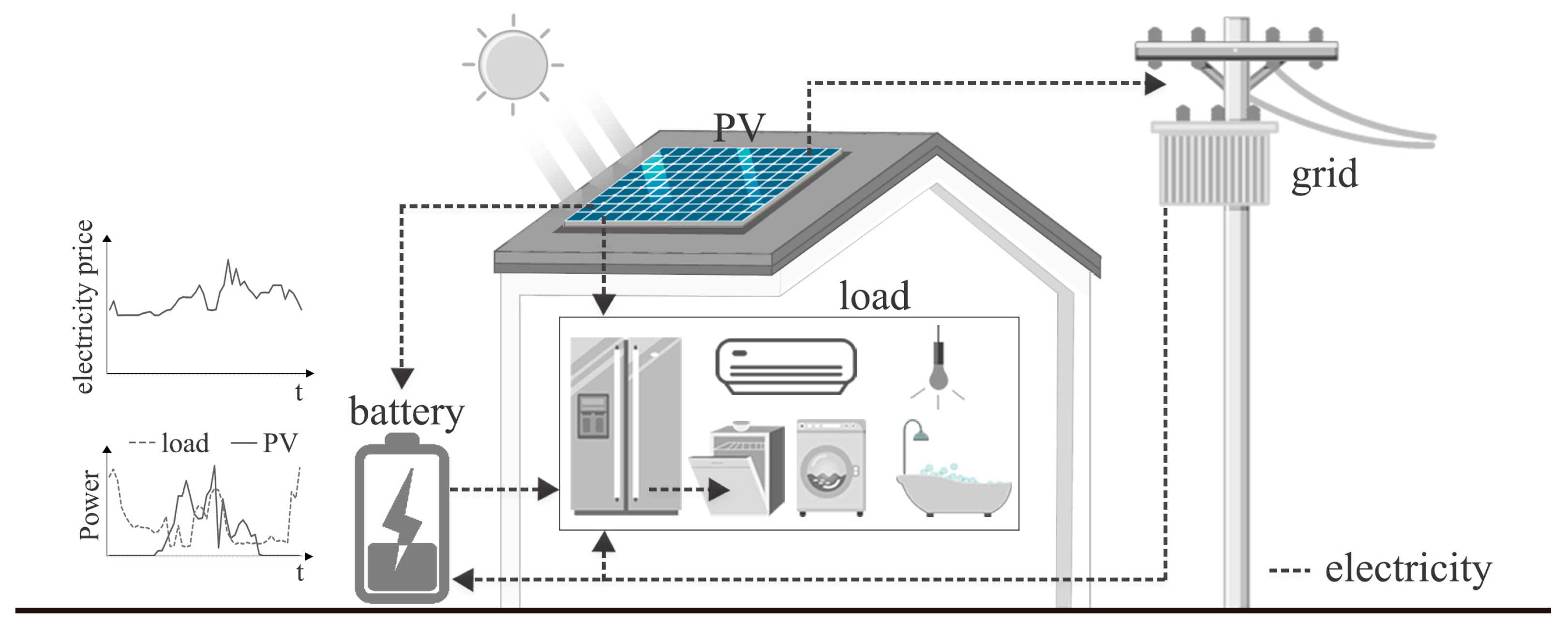
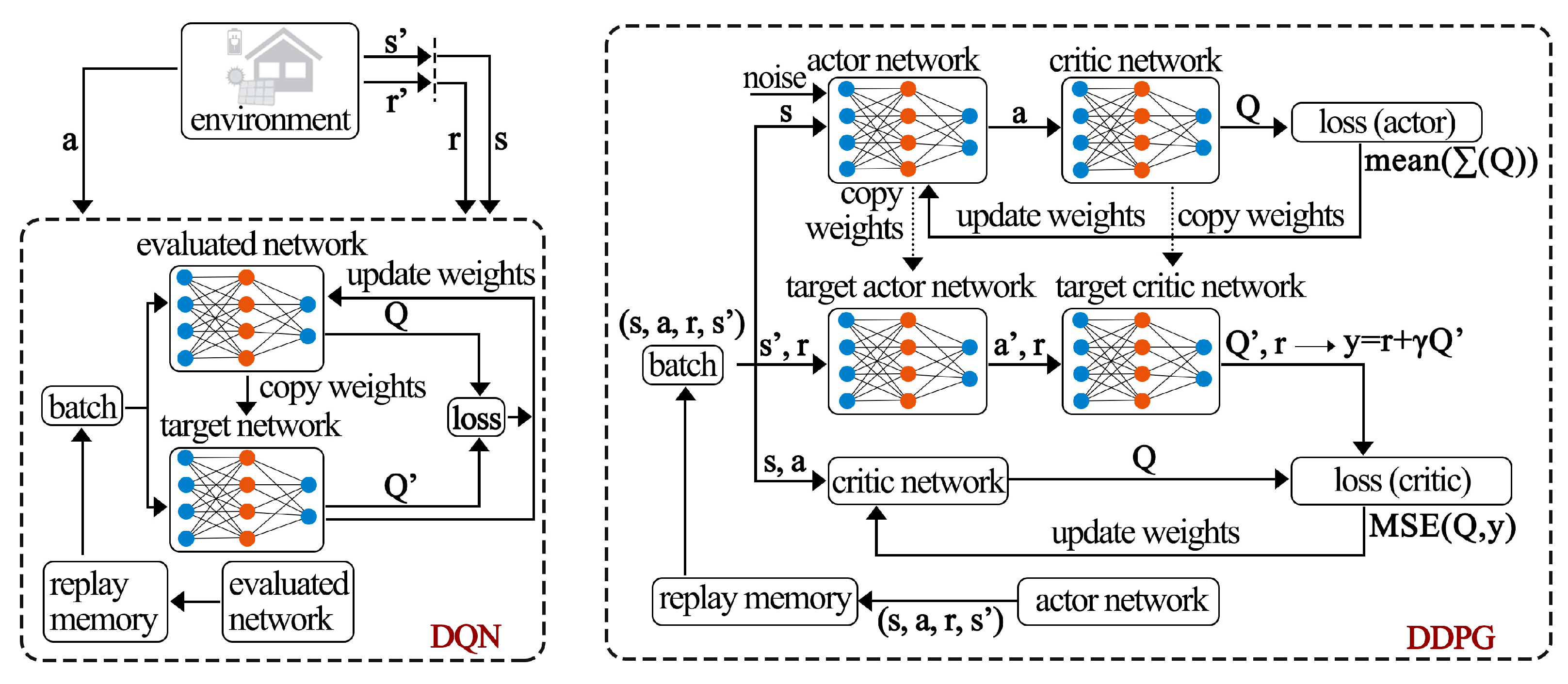
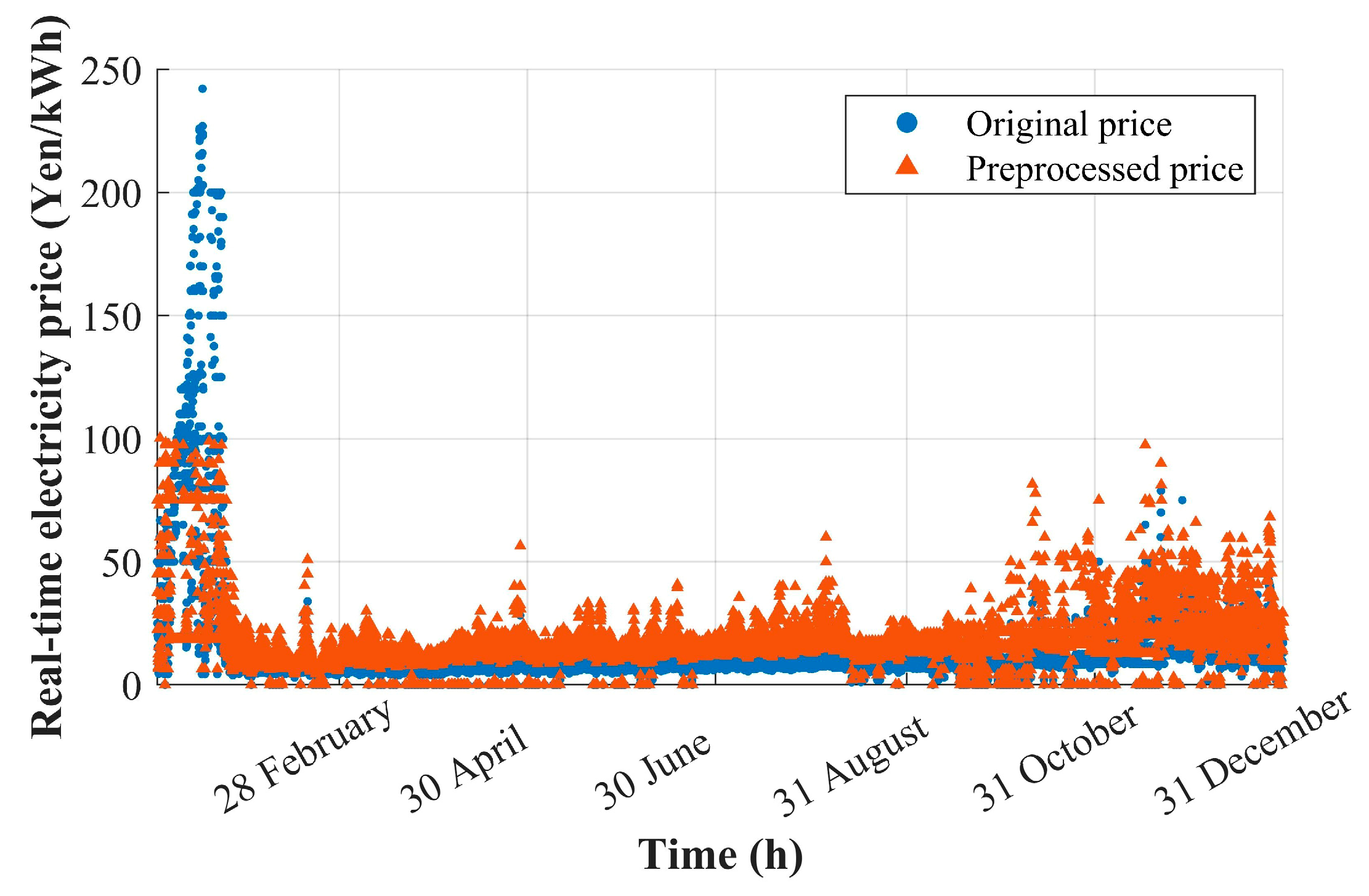

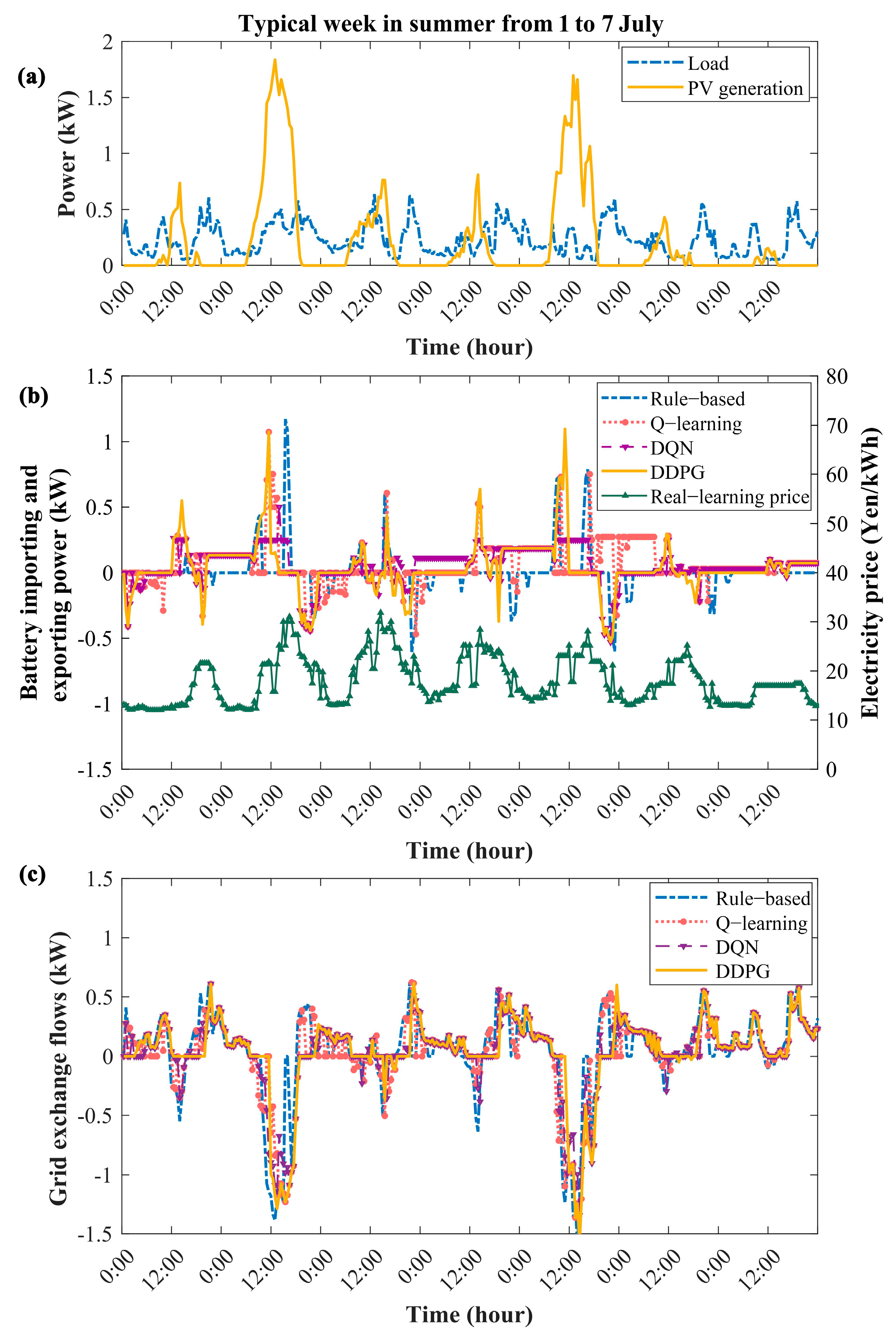
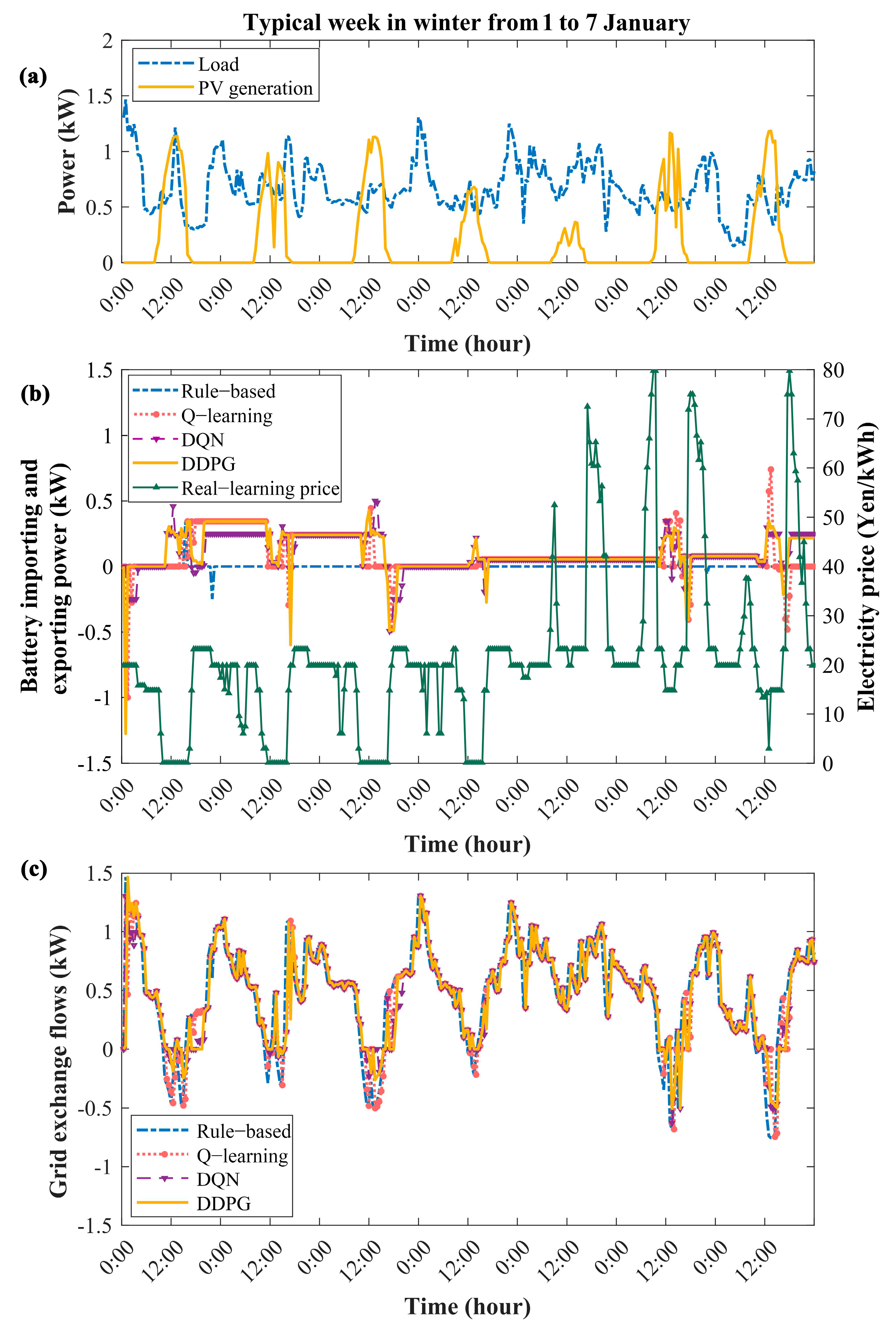
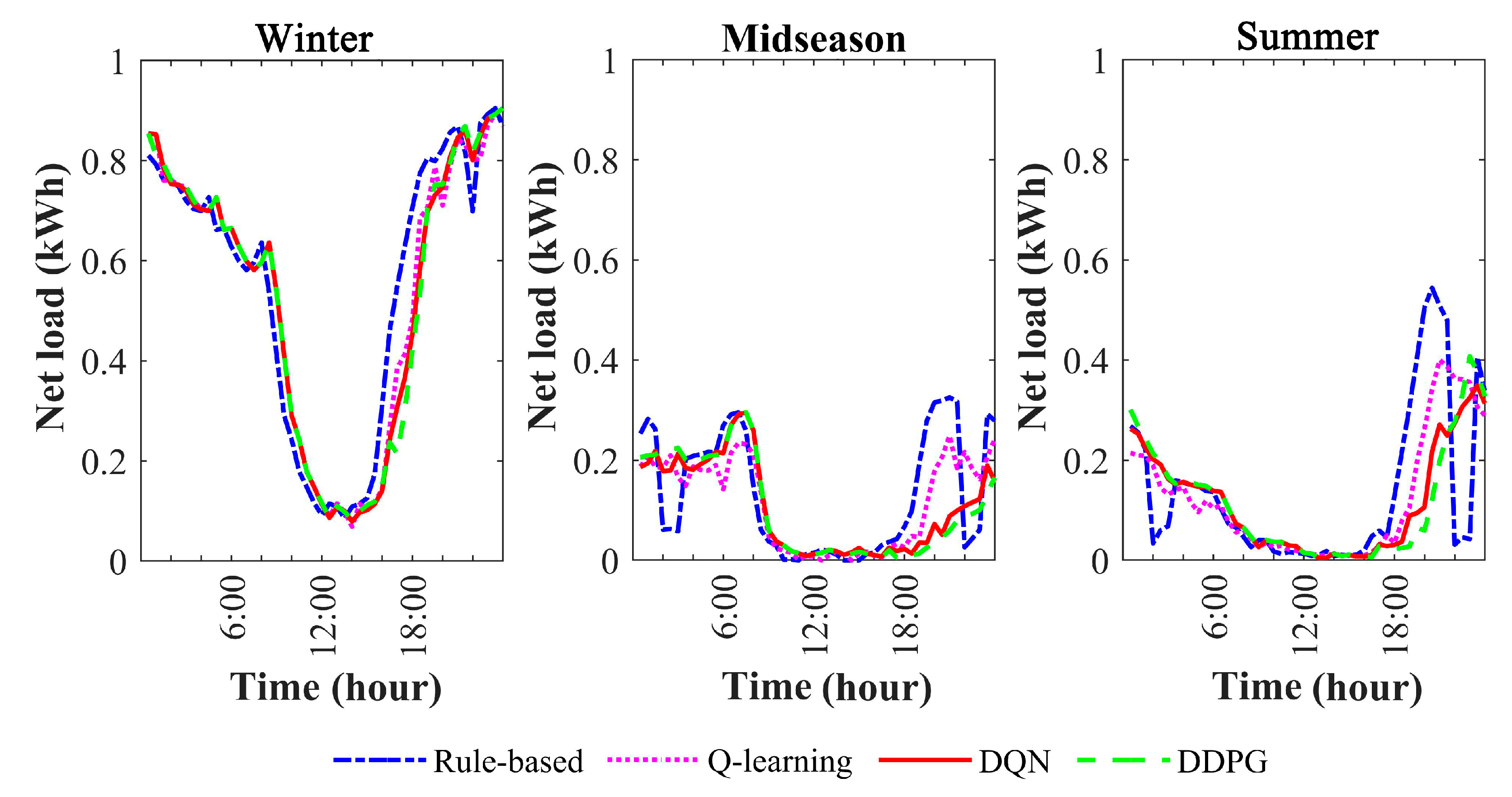
| Ref. &Year | Algorithm | Object | Model | Control Action | Reward | Purpose |
|---|---|---|---|---|---|---|
| Sara Abedi et al., 2022 [32] | Q-learning | Residential energy management | Model-free | Charge and discharge power of battery | Energy cost drawn from the grid | Storage efficiency, energy cost saving |
| Mohammed H. Alabdullah et al., 2022 [33] | DDQN | Microgrid energy management | Model-free | Power of the generation system, charge and discharge power of the storage system | Operational costs and penalty for violating power flow constraints | Calculation efficiency and operational cost saving |
| Rendong Shen et al., 2022 [34] | DDQN | Building energy management | Model-free | Airflow ratio, battery state of charge | Energy cost, unconsumed amount of renewable energy, thermal comfort | Equipment control considering comfort |
| Zhiqiang Wan et al., 2018 [35] | DQN | Residential energy management | Model-free | Electricity from grid | Energy cost and penalty for violating the allowed minimum SOC | Power cost saving |
| Sepehr Sanaye et al., 2021 [23] | DQN | Residential area energy management | Model-based | Load of combined heat and power generation, heat from gas water heater | Total operational cost at current time interval | Energy cost saving, self-sufficiency ratio |
| Alexander Dreher et al., 2022 [36] | PPO | Wind power and Hydrogen storage system | Model-based | Electrolyzer power | Electrolyzer applicable operational set point, power demand of the hydrogen compressor, amount of hydrogen, and natural gas utilized | Opportunity cost |
| Samir Touzani et al., 2021 [30] | DDPG | HVAC system and battery system | Model-free | Air supply temperature and flow, charging and discharge power of battery | Energy purchased from the grid/Energy cost, the penalty for the violation of the temperature comfort zone, and battery physical limits | Energy cost saving considering thermal comfort |
| Yuan Gao et al., 2022 [37] | DDPG& TD3 | Office building energy management | Model-free | Continuous control of biomass generator, PV and battery | Amount of electricity purchased, and penalty for violating the given minimum and maximum SOC | Off-grid operation and battery safety |
| Parameter | Q-Learning | DQN | DDPG |
|---|---|---|---|
| Discount factor γ | 0.9 | 0.9 | 0.9 |
| Learning rate α | 0.001 | 0.001 | 0.001 |
| ε-greedy initial value | 0.9 | 0.9 | 0.9 |
| ε-greedy decay factor | 0.9 | 0.9 | 0.9 |
| ε-greedy minimum value | 0.01 | 0.01 | 0.01 |
| Replay memory capacity | - | 100,000 | 100,000 |
| Batch size | - | 32 | 32 |
| Target net update steps | - | 300 | 300 |
| Number of hidden layers | - | 2 | 2 |
| Number of hidden units | - | (64, 64) | (64, 64) |
| Soft update coefficient | - | - | 0.01 |
| Variables | Formula | Definition |
|---|---|---|
| Self-sufficiency ratio [14,45,46,47] | The ratio of renewable power consumed by the user to total load demand. | |
| Self-consumption ratio [14,45,46] | The ratio of renewable power consumed by the user to total renewable power. | |
| Feed-in ratio [48,49] | The ratio of renewable power sold to the grid to total renewable power. |
| Algorithm | Self-Consumption Ratio | SELF-Sufficiency Ratio | Feed-in Ratio |
|---|---|---|---|
| Rule-based | 43.3% | 32.2% | 53.7% |
| Q-learning | 47.4% | 35.2% | 48.7% |
| DQN | 46.7% | 34.7% | 45.7% |
| DDPG | 49.4% | 36.7% | 44.1% |
| Typical Month | Winter | Midseason | Summer | |
|---|---|---|---|---|
| Variables | ||||
| Self-consumption ratio | Rule-based | 73.0% | 27.2% | 44.2% |
| Q-learning | 79.2% | 31.5% | 46.4% | |
| DQN | 78.1% | 31.7% | 47.4% | |
| DDPG | 80.0% | 34.0% | 48.6% | |
| Self-sufficiency ratio | Rule-based | 19.9% | 44.3% | 56.8% |
| Q-learning | 21.6% | 51.3% | 59.6% | |
| DQN | 21.3% | 51.7% | 60.9% | |
| DDPG | 21.8% | 55.5% | 62.4% | |
| Feed-in ratio | Rule-based | 26.2% | 69.4% | 51.7% |
| Q-learning | 15.9% | 64.2% | 48.9% | |
| DQN | 12.5% | 61.2% | 46.4% | |
| DDPG | 10.1% | 60.3% | 45.8% |
| Typical Month | Winter | Midseason | Summer | Total Cost | |
|---|---|---|---|---|---|
| Operation Cost (Yen) | |||||
| Rule-based | 23,076 | −3053 | −2888 | 43,301 | |
| Q-learning | 22,749 | −2995 | −3712 | 41,374 | |
| DQN | 22,616 | −2987 | −3715 | 40,868 | |
| DDPG | 22,528 | −3040 | −4201 | 40,201 | |
Disclaimer/Publisher’s Note: The statements, opinions and data contained in all publications are solely those of the individual author(s) and contributor(s) and not of MDPI and/or the editor(s). MDPI and/or the editor(s) disclaim responsibility for any injury to people or property resulting from any ideas, methods, instructions or products referred to in the content. |
© 2023 by the authors. Licensee MDPI, Basel, Switzerland. This article is an open access article distributed under the terms and conditions of the Creative Commons Attribution (CC BY) license (https://creativecommons.org/licenses/by/4.0/).
Share and Cite
Xu, W.; Li, Y.; He, G.; Xu, Y.; Gao, W. Performance Assessment and Comparative Analysis of Photovoltaic-Battery System Scheduling in an Existing Zero-Energy House Based on Reinforcement Learning Control. Energies 2023, 16, 4844. https://doi.org/10.3390/en16134844
Xu W, Li Y, He G, Xu Y, Gao W. Performance Assessment and Comparative Analysis of Photovoltaic-Battery System Scheduling in an Existing Zero-Energy House Based on Reinforcement Learning Control. Energies. 2023; 16(13):4844. https://doi.org/10.3390/en16134844
Chicago/Turabian StyleXu, Wenya, Yanxue Li, Guanjie He, Yang Xu, and Weijun Gao. 2023. "Performance Assessment and Comparative Analysis of Photovoltaic-Battery System Scheduling in an Existing Zero-Energy House Based on Reinforcement Learning Control" Energies 16, no. 13: 4844. https://doi.org/10.3390/en16134844





